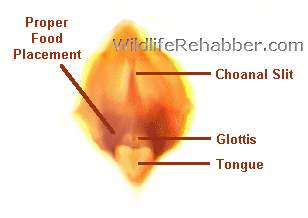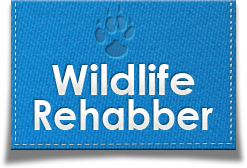Emergency Care
Once you have determined that this wild bird or mammal needs help, you should confine the bird or mammal and immediately contact a wildlife rehabilitator by phone. Your personal safety should always be a key factor. Always take appropriate measures to prevent personal injury from bites or coming in contact with saliva or other bodily fluids of mammals.
Be prepared to transport wildlife to a wildlife rehabilitator. Remember that wildlife rehabilitators are volunteers; they do not get paid to feed or care for wildlife. They are not like animal control; they do not get paid to pick up wildlife. Let wildlife rehabilitators focus on what they do best…caring for wildlife. Please do not ask them to do more than they already.
To transport orphaned wildlife:
- Place the babies in a softly-lined covered box with ventilation.
- Place the box in a warm, dark quiet indoor location away from all humans and pets
- Do Not attempt to give it food or water, no matter how much it begs!
The only recommended Emergency Care that should ever be provided if treatment by a wildlife rehabilitator will be delayed, is to provide a source of hydration (if more than 4 hours until transport) and possibly supplemental heat.
Before attempting to provide Emergency Care, please screen the baby’s health first to ensure there are no other complications . Also, this Emergency Care guide assumes that the mammal/bird will be taken to a rehabilitator within a matter of hours. If transport will be delayed more than 24 hours, please contact a rehabilitator near you for further care instructions. Remember that the sooner wildlife are in the hands of an experienced wildlife rehabilitator, the better its chances are for survival.
Supplemental heat should be provided to any mammal baby that is not fully furred with eyes still closed, and to any baby bird that is naked or only partially feathered. A warm room or your body heat will not provide enough supplemental heat. House the baby in a very small covered box (a shoe box is best) lined with a small handtowel (put small ventilation holes in the box first). Next, place half of the box onto a heating pad set at low/medium. The goal is to heat the air inside the box, not directly heat the baby. Towels are used to diffuse the heat to prevent direct contact with the baby. Frequently check the settings to ensure the baby is not overheated.
The next step is to provide a source of hydration. The recommended hydration method is different for mammals and birds.
For mammals, use a rehydrating solution like Gatorade or Pedialyte. Every two hours until the mammal can be transported, place small droplets on the tip of the animal’s lips. If it is responsive and laps up the water droplets, continue providing droplets. If the animal is unresponsive or shows signs of becoming stressed (breathing hard, eyes closed, becoming very still), stop immediately and leave the animal in a covered box until it can be transported. NEVER put the liquid inside the animal’s mouth. If it is too weak to swallow, then it will inhale the liquid, and possibly develop aspiration pneumonia. Please do not provide a pet store milk replacer unless a rehabilitator has given you specific preparation and dilution instructions. Rehabilitators closely match a milk replacer with the composition of each species’ mother’s milk and slowly introduce it very watered down levels to prevent complications such as bloat or even death.
For birds, there is an increased risk of aspiration pneumonia because the opening to their airway (called the “glottis”) is located at the base of their tongue. NEVER put any liquid inside the bird’s mouth. The safest, best method for providing a source of fluids is by using thin slivers of peeled fruit. The fruit must not contain any peel, because certain species of birds may not be able to digest them. Fruits that contain a low acidity level and are high in water content are best: grapes, watermelon, plums, etc. Tiny slivers of scrambled eggs are also acceptable, but the moisture content is low and should be alternated with slivers of peeled fruit. This should be repeated every 30 minutes until the bird can be transported to a wildlife rehabilitator.
 Each piece should be placed at the rear of the bird’s right side of the mouth. Pay careful attention to ensure that you go above and behind the glottis (see photo). Avoid letting any food or liquid particle get near the glottis, otherwise the bird will develop aspiration pneumonia. Allow the bird to close its beak and swallow. If the bird is reluctant to swallow, gently stimulate the base of its beak and throat. Sometimes setting the bird down will encourage swallowing. If the bird refuses to open its beak or is incapable of swallowing, do not attempt to pry or force it open. The delicate structure of the beak (similar to cartilage) can easily be permanently damaged. Stop immediately and leave the bird in a covered box until it can be transported.
Each piece should be placed at the rear of the bird’s right side of the mouth. Pay careful attention to ensure that you go above and behind the glottis (see photo). Avoid letting any food or liquid particle get near the glottis, otherwise the bird will develop aspiration pneumonia. Allow the bird to close its beak and swallow. If the bird is reluctant to swallow, gently stimulate the base of its beak and throat. Sometimes setting the bird down will encourage swallowing. If the bird refuses to open its beak or is incapable of swallowing, do not attempt to pry or force it open. The delicate structure of the beak (similar to cartilage) can easily be permanently damaged. Stop immediately and leave the bird in a covered box until it can be transported.
Do not provide insects, worms, soaked dog food, or any other form of solids unless you have spoken with a wildlife rehabilitator and have been instructed to do so. Remember that a source of hydration is most important, and unless a rehabilitator has instructed you to feed solids to the baby it could prove fatal. There is no “one-size-fits-all” substitute diet for birds. A rehabilitator must first identify the species to determine the protein/calcium/etc. requirements of that particular species and then formulate a diet to match those requirements.
Special Considerations: Mourning doves and pigeons will not open their beaks for feedings. Instead, they will lift their heads, make a “weeping” sound and prod their beak around in search of a parent’s beak to pry open. These babies must be fed by crop tubing by an experienced rehabilitator.





